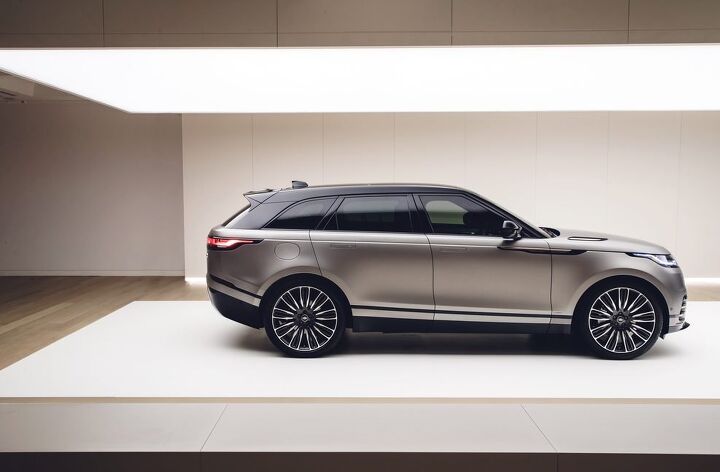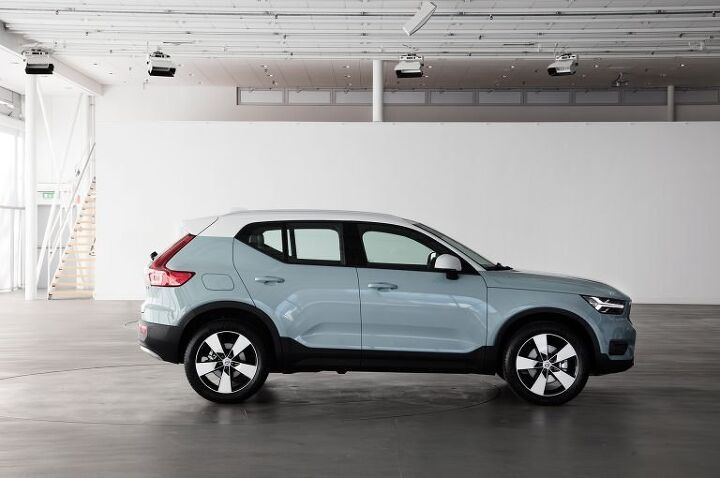Are Two-tone Paint Jobs the Next Big Automotive Trend?

Contrasting paint hasn’t been commonplace on automobiles in over half a century, but it appears to be regaining some of its lost momentum lately. Everything from the Bugatti Chiron to the Toyota Camry offers separate bodywork hues these days.
Of course, we don’t know if this is a trend poised to explode across the industry or something that will be relegated to a handful of models before fizzling out. However, with new crossovers like the Volkswagen T-Roc, Range Rover Velar, and Volvo XC40 available with contrasting rooflines, it seems ready to enjoy at least 15 minutes of fame.
According to Automotive News, manufacturers have at least realized they’re onto something. Ford’s former head of design, J Mays, admitted to being heavily influenced by the returning Mini’s two-tone color scheme while working on the retro-inspired Flex.
“I would be lying if I said I wasn’t influenced by the first-generation New Mini, which had beautiful wraparound glass and this lovely little skullcap in white and later in black,” he said. “[The Flex’s white roof] added a little bit of panache to the car and made it feel a bit like a modern-day woody, which is what we were trying to do.”
“I think it influenced a lot of other manufacturers,” Mays continued. “Some of them are quite successful, and some are really terrible, but everyone seems to have jumped on that bandwagon.”
Dozens of cars, mainly crossovers and SUVs, have received the treatment since the early 2000s. Automakers saw that they could dramatically alter the persona of a given model, adding an element of fun or class, and the trend started to take hold in Europe before spilling over to the rest of the globe.
“It’s incredible how people react to the bitone colors,” stated Alexandre Malval, head of design at Citroen, which offers two-tone options on four models. “If you give them two colors to assemble, immediately the car has different personalities. Red with a white roof is a little bit sporty; cream with a black roof is a little more solid and tough. One in pastel with a white roof could be a little more feminine.”
The downside is that two-tone models often increases the cost of production. Sending a model through for a second coat of entirely different paint takes more time, money, and effort than a single solid color — which easily results in a higher MSRP.
“Bitone paint finishes are always more labor intensive because of the masking they require,” a spokeswoman from Axalta Coating Systems in Switzerland explained. “That means the need for more people, which in turn can mean the potential for mistakes.”
The second color is applied either in a second line, which means additional investment, or via a second run on the main line, which reduces capacity. This is one of the reasons most manufacturers are only offering bitone paint as an optional extra on a handful of models.
“The demand is much higher than we thought,” said Matthew Harrison, vice president of sales and marketing at Toyota Motors Europe. “One of our headaches is keeping up with the bitone trend. We’re having to constantly argue with manufacturing to raise the production capacity levels.”
Hopefully its a trend you’re fond of, as the odds are good it will persist for at least a few more years. Manufacturers are developing solutions to make the process less intensive and more are opting into having it as a standard option. Volvo, for example, baked the two-tone concept into the XC40 from day one. It offers two separate trims with distinctive roof colors as well as a single-color variant.
However, no trend lasts forever.
“Ubiquity usually relegates everything to the trash bin,” Mays explained. “The companies that have this as part of their brand DNA like Mini or Land Rover, it won’t go out of style … It’s going to be one of those things you look back on in 10 years’ time and say, ‘Oh yeah, that was from that era right around 2016-2017 when everybody seemed to be doing two-tone.'”
[Images: BMW Group, Volvo Cars, Land Rover]

A staunch consumer advocate tracking industry trends and regulation. Before joining TTAC, Matt spent a decade working for marketing and research firms based in NYC. Clients included several of the world’s largest automakers, global tire brands, and aftermarket part suppliers. Dissatisfied with the corporate world and resentful of having to wear suits everyday, he pivoted to writing about cars. Since then, that man has become an ardent supporter of the right-to-repair movement, been interviewed on the auto industry by national radio broadcasts, driven more rental cars than anyone ever should, participated in amateur rallying events, and received the requisite minimum training as sanctioned by the SCCA. Handy with a wrench, Matt grew up surrounded by Detroit auto workers and managed to get a pizza delivery job before he was legally eligible. He later found himself driving box trucks through Manhattan, guaranteeing future sympathy for actual truckers. He continues to conduct research pertaining to the automotive sector as an independent contractor and has since moved back to his native Michigan, closer to where the cars are born. A contrarian, Matt claims to prefer understeer — stating that front and all-wheel drive vehicles cater best to his driving style.
More by Matt Posky
Latest Car Reviews
Read moreLatest Product Reviews
Read moreRecent Comments
- Ollicat Another Biden attempt to say, "Look over there!"
- Kjhkjlhkjhkljh kljhjkhjklhkjh Who cares. Price of gas is not the issue. spending an extra 100$ a month over 4 tanks of gas is not the issue.this a political scam to distract really dumb people from the real issue. if rent and house payments were not up by 50% to as high as 150% higher in a ton of locations, then paying an extra 100$ in gas would be annoying but not really an issue. But the real-estate market with hedge fund investors, power-relator groups bought a ton of houses and flipped them into rentals and jacked up the rates uplifting the costs on everything else. and ironically no-one seems to be in any hurry to build more houses to bring those costs down because supply and demand means keeping less houses available to charge as much as you want. It is also not the issue as a secondary issue is child care costs and medical... again 100$ extra per month in gas is *nothing* compared to 800$ a month in ''child care'' and 300$ per visit to the doctor office, 300$ for a procedure less dentist trip..
- Ajla Is there something proprietary or installed on the moon with these that I'm not aware of?
- Tane94 Awaiting the EV3 unveil this month. Kia continues to lead, though I will miss the Soul
- Jeanbaptiste I know this will never be seen, but the real answer is NO Government mandated tech. The reason why is that when the government mandates something, we miss out on signals that the free market will give to weather or not people actually want this or that this tech would actually help. It's like mandating AM radio for cars when people could just buy a $10 am radio if they really like am so much.




































Comments
Join the conversation
I have NEVER, EVER seen a two-tone paint job that I thought looked good.
Hello, Ford? 1983 wants its paint job back.